The notion of ‘a layered history’ takes on a whole new meaning in textile artist Jean Littlejohn’s hands. Her work ‘Taepa’s Portal’ literally captures hundreds of years of period designs in a single piece through fabric layers and varied stitching techniques. And now you can learn how it all came together with this very generous insider’s look from Jean herself.
Pay special attention to her use of an embellishing machine, which she thinks is often underestimated. It’s incredible how she uses it for mark-making by stitching on both sides of her fabric layers.
This piece was showcased at a recent exhibition called ‘Side by Side’ that Jean hosted with her artistic partner, Jan Beaney. Jean and Jan are not only world-renown for their individual textile art, but they’re also seen as cutting-edge educators across the globe. Their publishing company called Double Trouble Enterprises offers a wide range of books, DVDs and digital workshops. Founded in 1997, Double Trouble has been providing inspiration and instruction to textile artists of all interests and abilities.
Jean is also a member of the 62 Group of Textile Artists and Artists Fellow of the Society of Designer Craftsmen. And she is an Honorary Member of the Embroiderers Guild.
Name of piece: Taepa’s Portal
Year of piece: 2018
Techniques and materials used: Layered and printed appliqué with hand and machine stitching plus embellishing machining. Mixed fibres including cotton and recycled materials
Size of piece: 74cm x 48cm
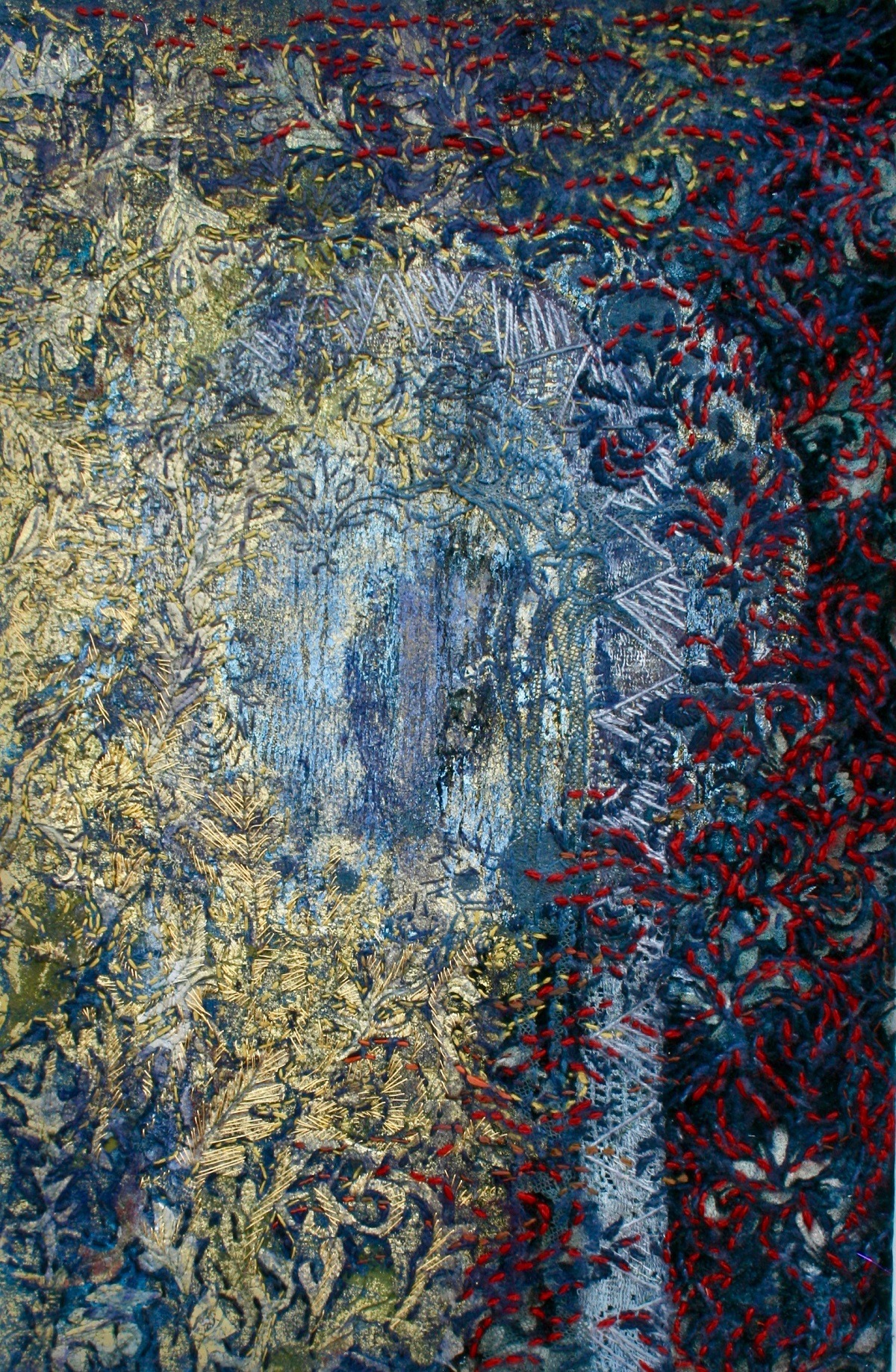
Stitching the past
TextileArtist.org: How did the idea for the piece come about? What was your inspiration?
Jean Littlejohn: This work is part of ongoing research into Taplow Court, a familiar local location with a continuous history of habitation of over 1,500 years. ‘Walking in the footsteps of our ancestors’ has been a source of fascination and inspiration for many years. And this place is particularly special, as I spent much of my childhood and teen years as a frequent visitor.
There are many pathways in the extensive grounds, and those who have trodden those paths have left their mark. Taepa, an Anglo-Saxon chieftain, Bishop Odo, Henry V111 and Queen Elizabeth I have all spent time in this special place. I seek to indicate layers of history through the construction of multi-layered cloths.
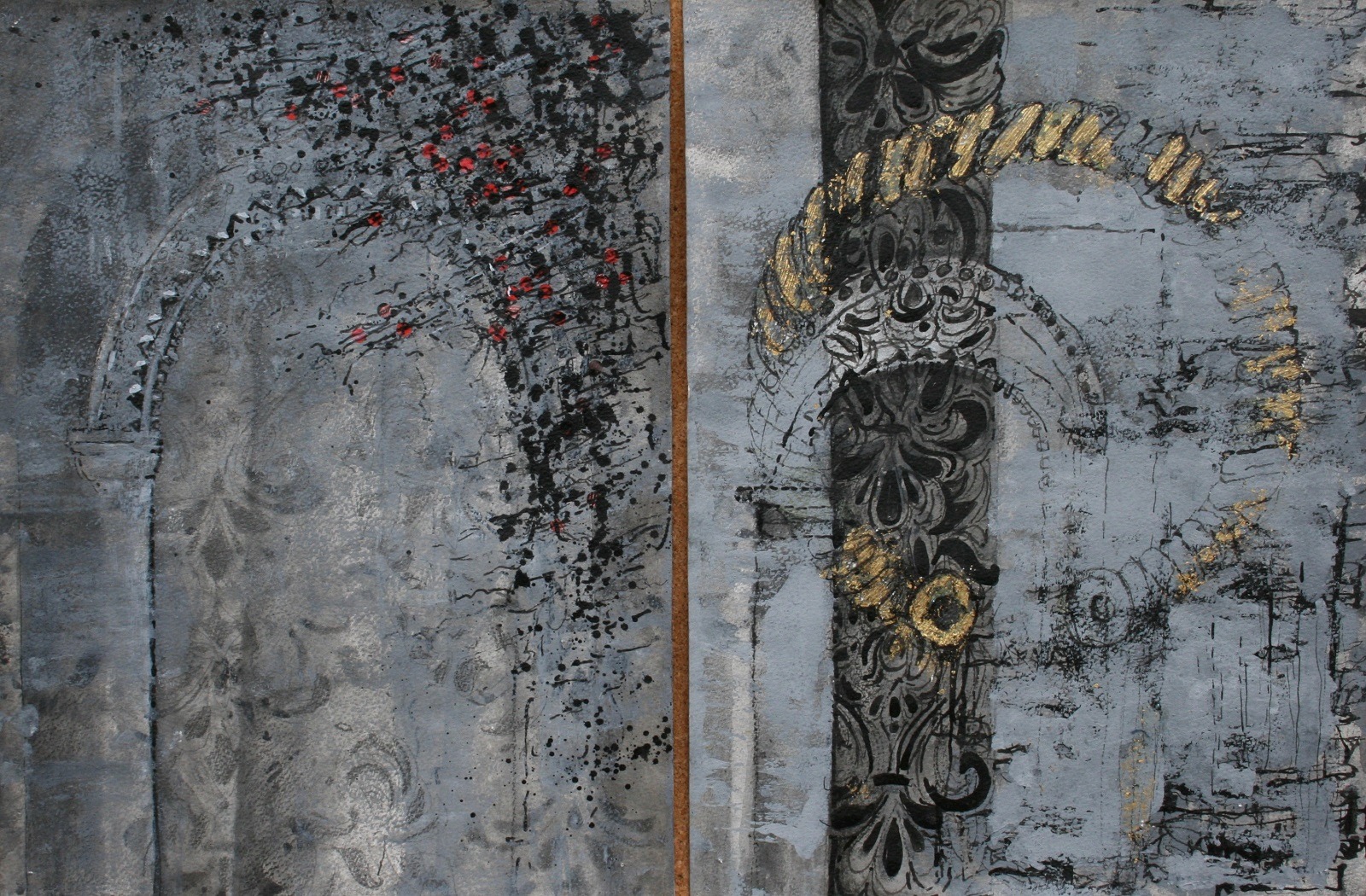
What research did you do before you started to make?
I researched the history of Taplow Court through books and historical documents. I used the fabric and patterns of the building and interiors for visual research.
I also studied Anglo Saxon artefacts excavated from the site that are now housed in the British Museum as symbols of the historical resonances.
Keeping sketchbooks is an important part of my practice. When working on-site, I use a small moleskin sketchbook that’s approximately 24 x 12 centimetres. I also use an A3 watercolour sketchbook for developing ideas.
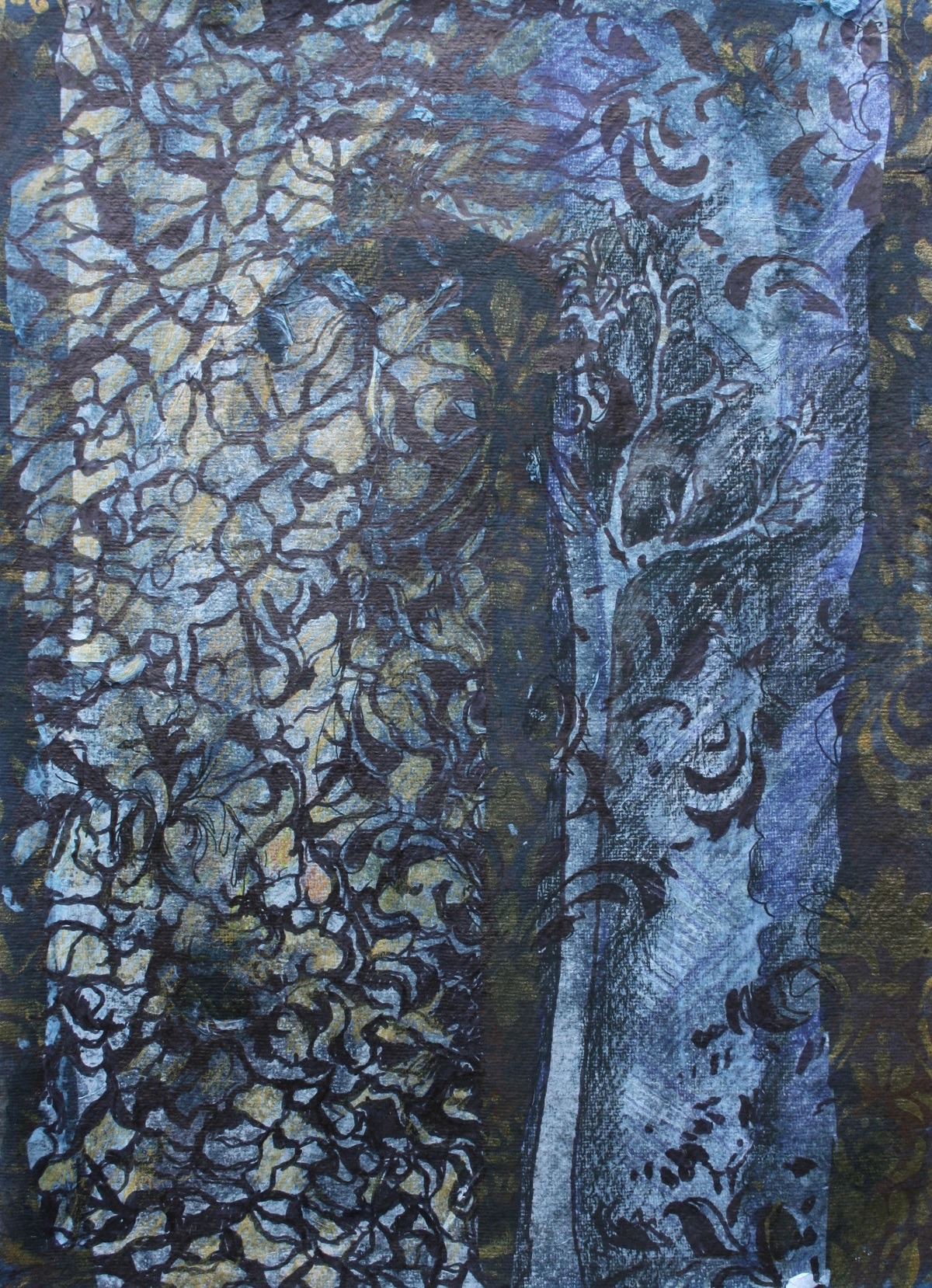
The power of needle punch
Was there any other preparatory work?
Preparatory work included numerous mixed media multi-layered design explorations. Typically, my methodology includes drawings combined with collage and print that I further enhance with drawing.
I then select areas and rework until I find imagery that I think will work in fabric and thread.
These explorations are carried out by hand. I occasionally use photocopying for enlarging images, but I do not use technology in any other way. I feel that physically handling the materials is very important to my working process.

What materials were used in the creation of the piece? How did you select them? Where did you source them?
If working on a background, I like to use soft, loosely-woven cotton, as hand stitching is usually a strong element of the work. Loosely-woven fabric makes hand stitching easier, particularly as my process involved building up layers which is tough on the hands.
I use a variety of wool, cotton and mixed fibre, all with scale and colour being the most important factor.
I also use dyed cotton scrim, as I like the quality of surface that it offers. Scrim has a soft, not-too-obvious texture which sits well with the process I use.
The applied pieces are usually contrasting textures such as velvets and laces that also further the thrust of the ideas of complex surfaces representing layers of history.
The fabrics I use are appropriate for the imagery. I often use recycled materials from clothes and other household sources. Old silk viscose blouses and cotton lace curtains have been particularly useful. The silk viscose shimmers and reflects light. And lace is fantastic for tearing and chopping into organic textures.
I also bond specific shapes of various types to backgrounds and use the embellisher to fuse and blend them in. This was the process used for this work.
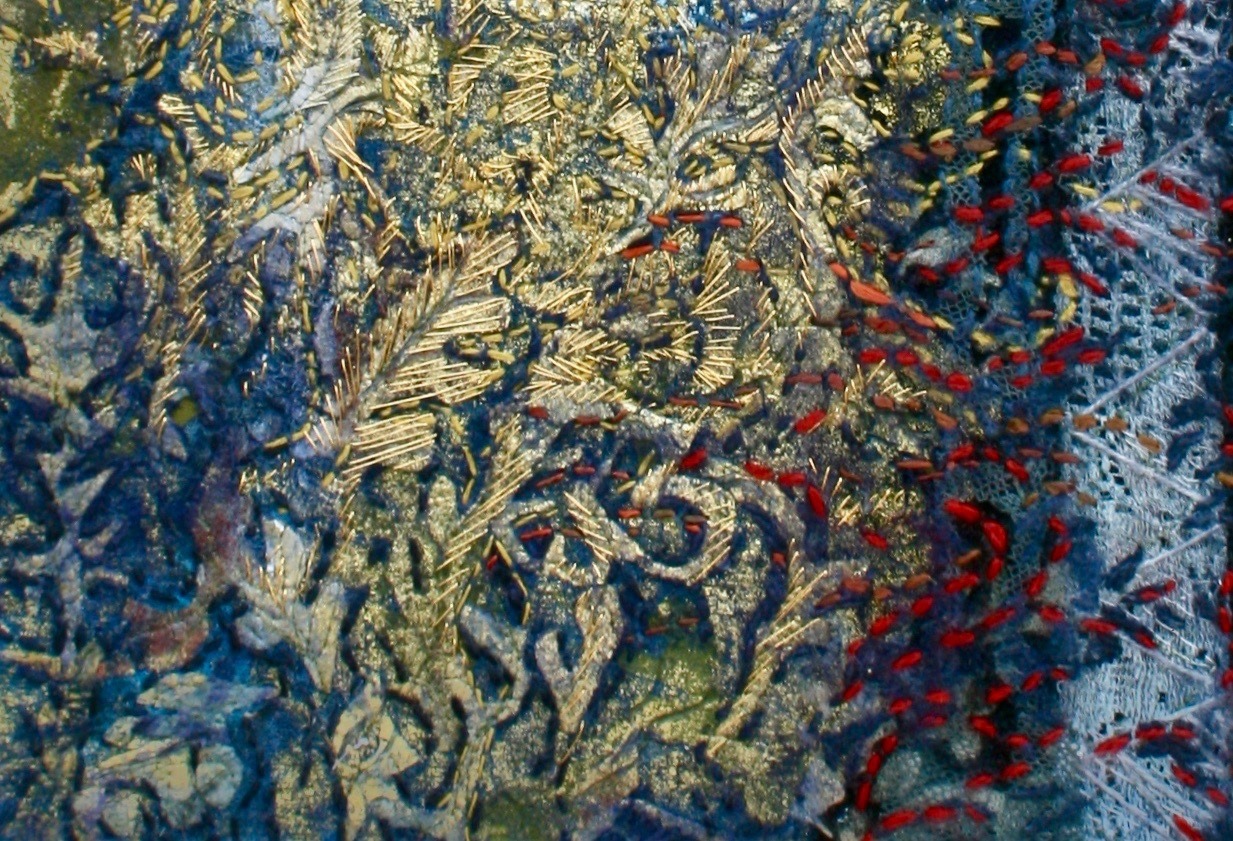
What equipment did you use in the creation of the piece and how was it used?
Hand and machine stitching are important elements in my work. But without doubt, the embellisher or needle punch machine has enabled me to combine and fuse layers in a unique way that has allowed me to think and plan.
The embellishing machine is often underestimated. It can subtly blend hand stitch into a background and ‘marry’ it to the surface. It can also be used from the reverse side when shapes and scrims from the reverse side can infuse themselves into the imagery on the front and create softened effects that I like to use in my work. I mostly use a Babylock embellisher.
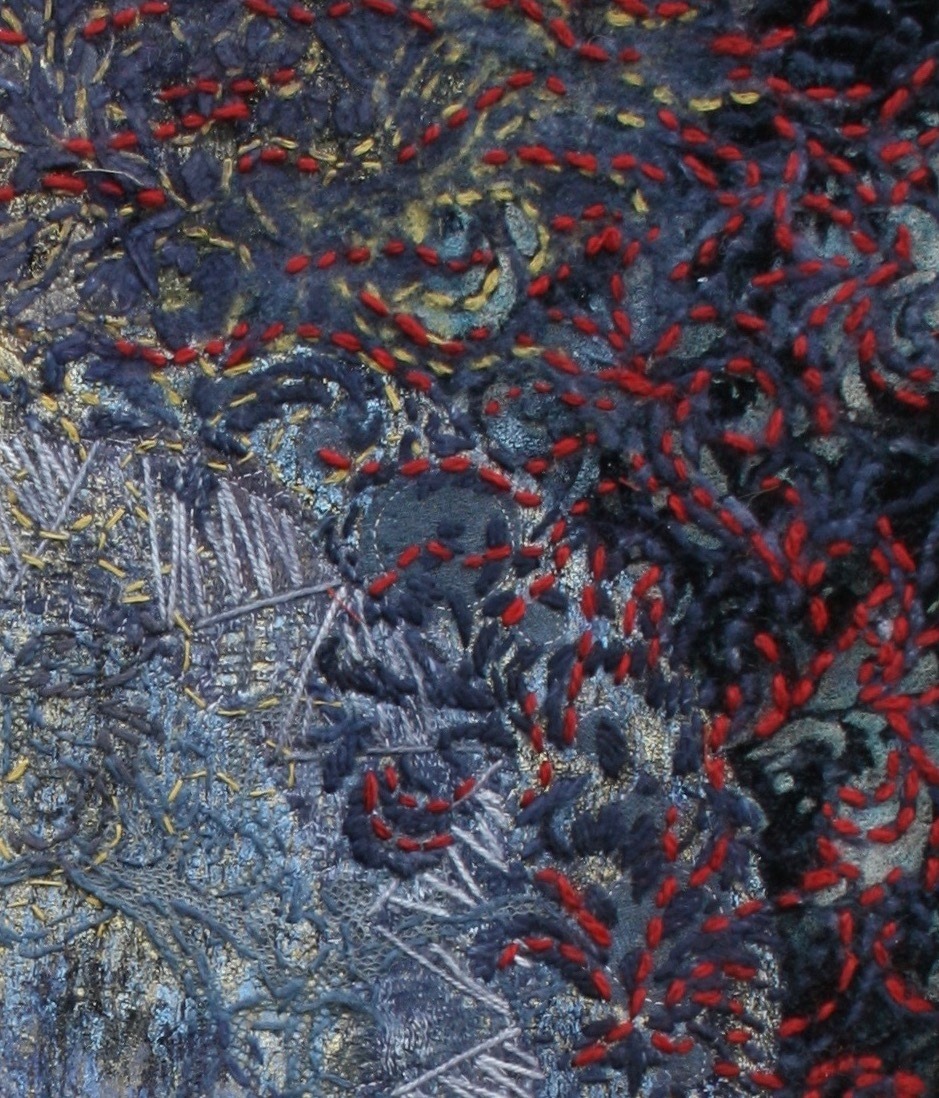
Creating layers
Take us through the creation of the piece stage by stage
This work incorporates a wide range of fabrics and techniques.
I always start by assembling a group of fabrics from which to select. I usually work in series and collect more materials than I need before making the final selection.
I dyed the background and some laces and velvets in a dark blue-black. I use Dylon washing machine dyes for large pieces and a variety of other dyes such as procion for smaller pieces.
Next, I printed on the background fabrics using discharge techniques with a range of stencils and printing blocks. I use Decolourant and Jacquard discharge pastes.
The first layer was cotton and the next a flat layer of dyed, printed scrim.
Foliage shapes and architectural details using velvets and laces were next bonded onto the surface and ironed firmly to secure.
Once this textured surface had been completed, a sheet of Bondaweb painted with acrylic paints was ironed over the whole image.
Gold Transfoil or printing foil was ironed over the outside shapes leaving the central portal without gold. The gold is symbolic of the ancient Anglo-Saxon treasures unearthed on the site. The foil was applied using an iron set to wool heat.
To complete the design, sheer polyester was ironed over the whole piece. Machine-stitching with toning threads echoed the shapes, followed by hand stitching.
An embellisher was used to blend the imagery and settle the stitching.
The piece was also embellished from the reverse side in some areas to give a softer more diffused effect. When worked from the front, the embellisher can ‘bruise’ stitches into the background fabric, but the structure of the stitch is still evident.
From the back, the embellisher will have a more vigorous effect and can fuse the stitches into a ‘felted’ effect. So, care needs to be taken not to overwork it and lose the character of the stitches.
To complete the work, further hand stitching enhanced the gilded shapes to the left of the design and the red decorative stitching to the right to reinforce the feeling of Victorian opulence.
After damp stretching, it was laced over mount board to achieve a flat crisp finish to enhance the texture.
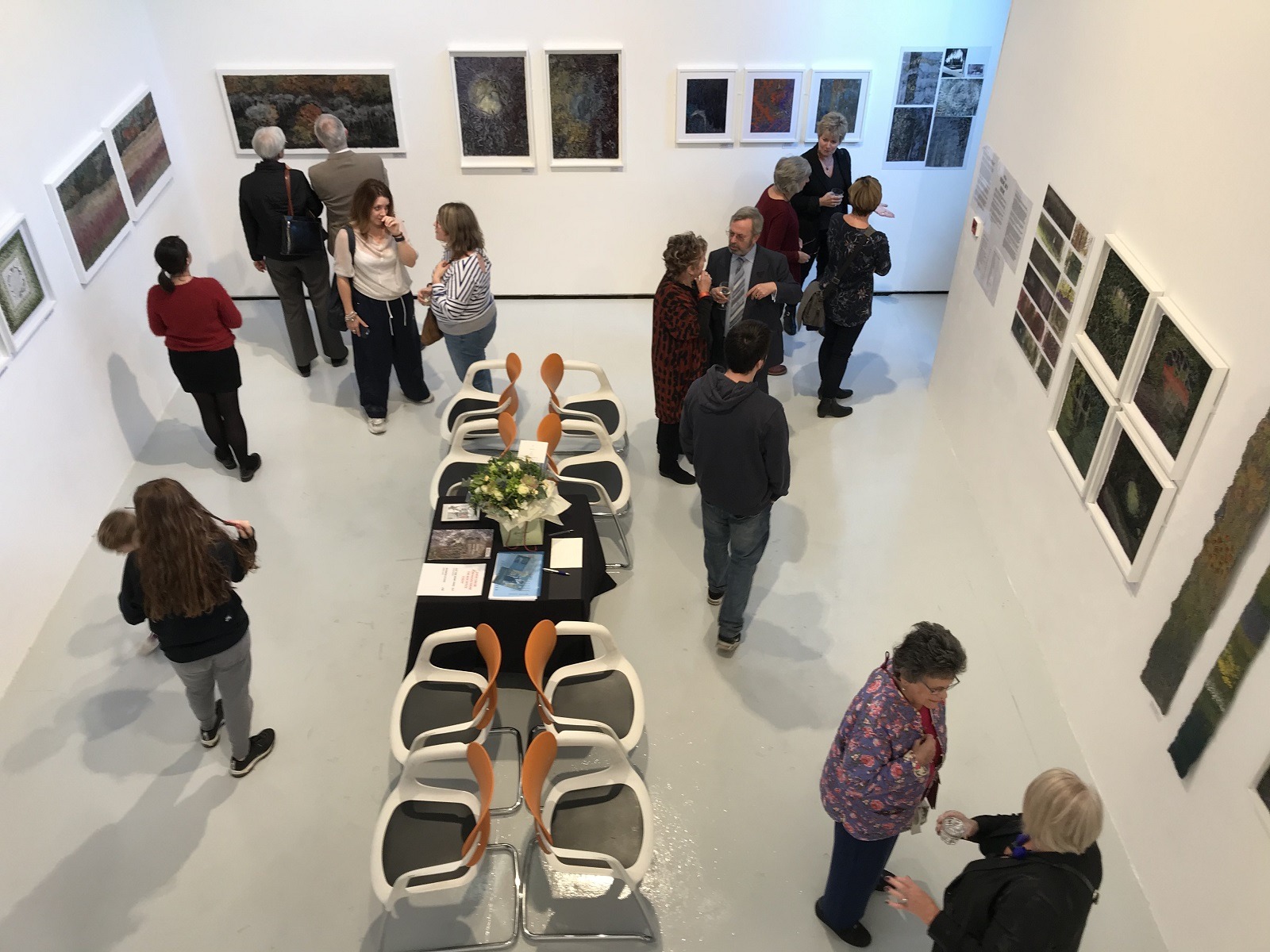
What journey has the piece been on since its creation?
This piece was sold at the Private Viewing of my and Jan Beaney’s exhibition ‘Side by Side’ that opened this past October. The exhibition dealt with two special locations that were next to each other in our area.
This work was previously exhibited in 2018 with the Society of Designer Craftsmen Summer Exhibition in London.

For more information visit doubletrouble-ent.com
How can you imagine using Jean’s layering techniques in your own work? Let us know below.
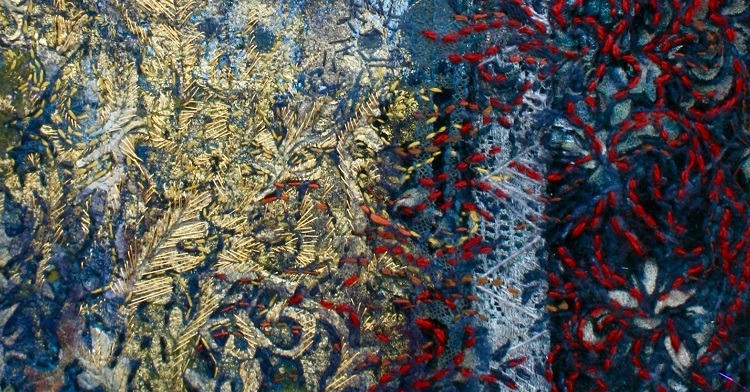

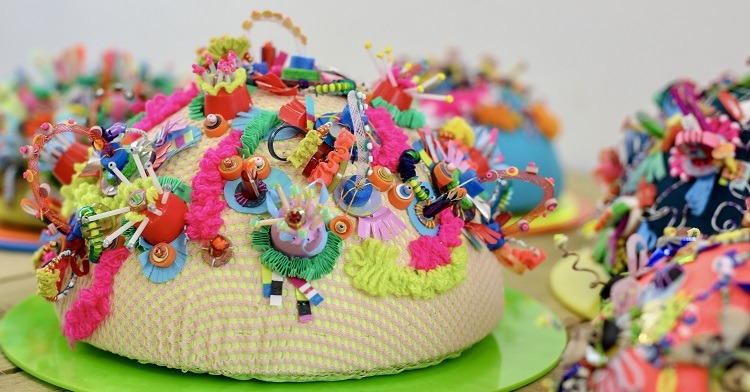
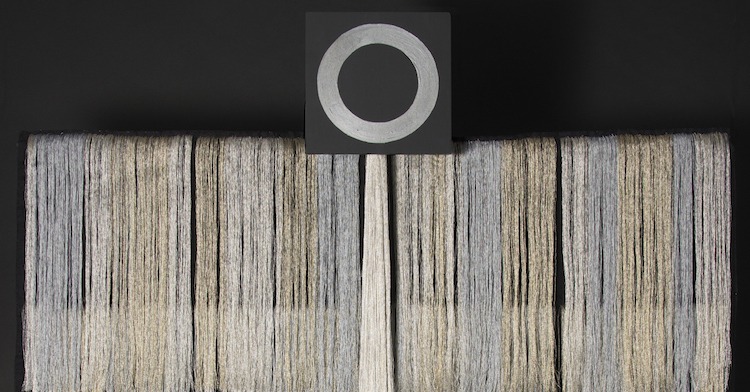
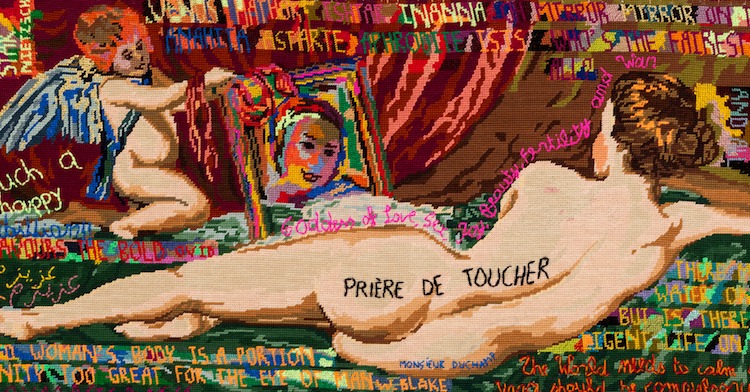
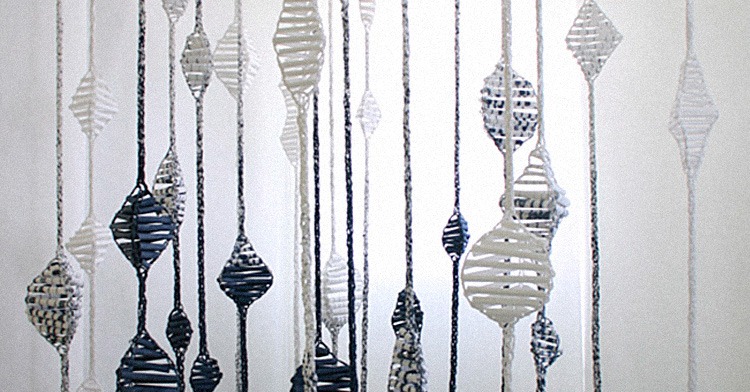
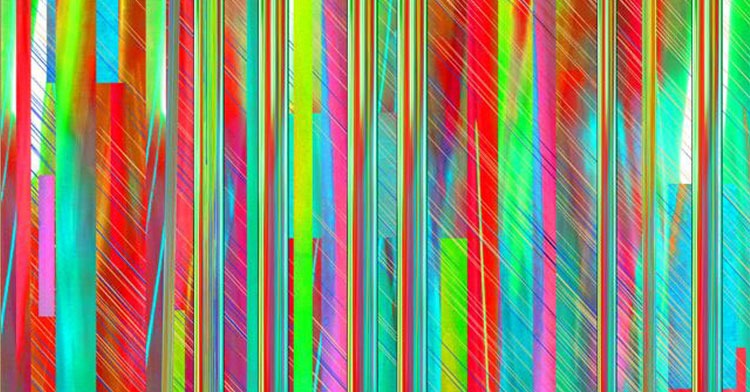
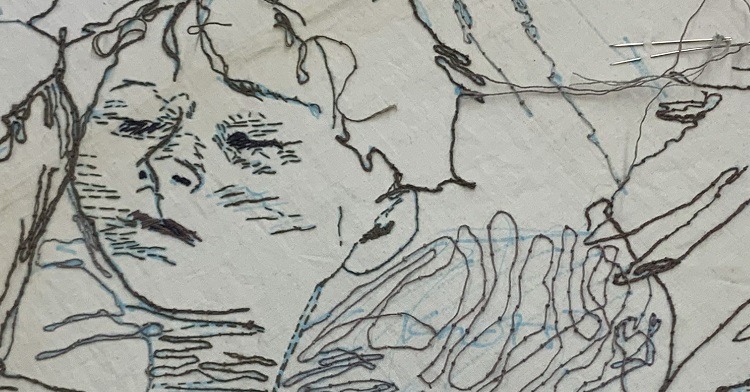
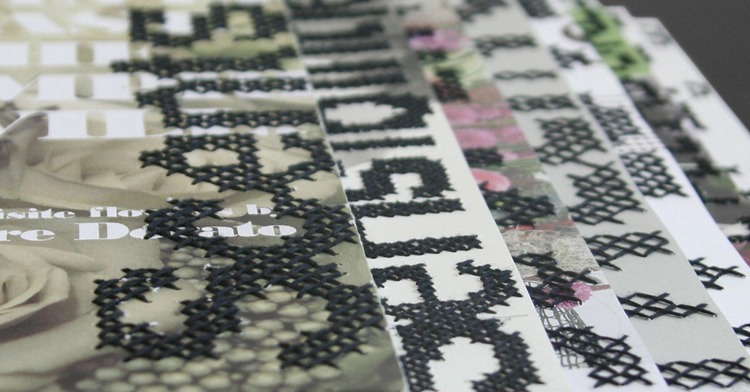
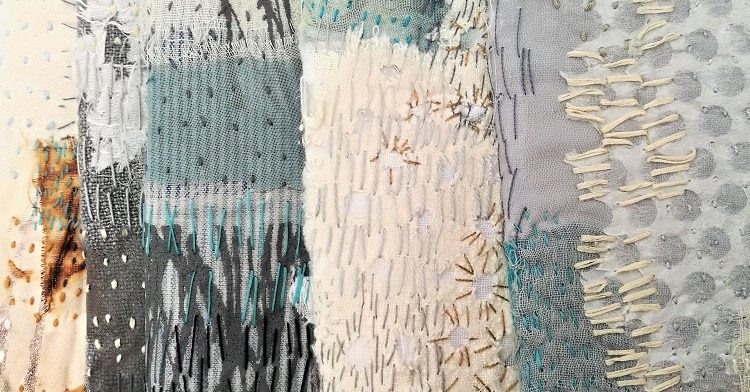
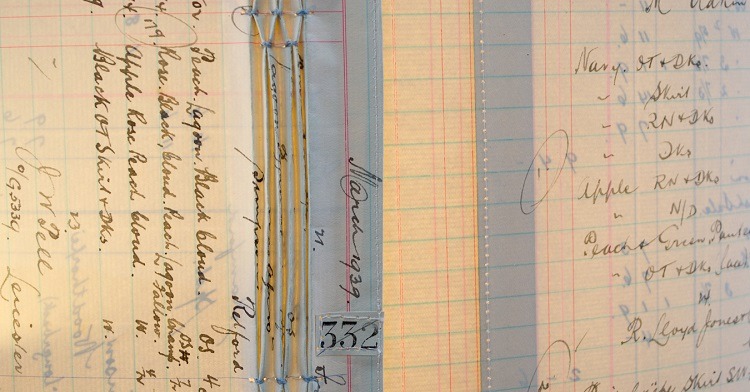
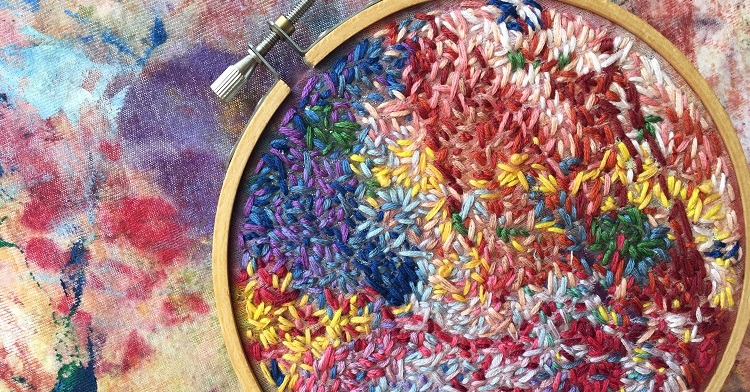
7 comments
Susan Smith
Fabulous inspirational work
Marina Hellbach
I discoevered The work from Jean Littlejohn and also from Jan Beaney.
It is so wonderful and rich. Even words can not tell how I feel by looking at that.
It is fantastic .
Marina Hellbach
Marilyn Coulson
I am so excited. I am a fiber artist and primarily do sewing projects or weaving. I am a 76 year old retired clinical social worker on disability Six years ago began three years of death, and tragedy in the family, including my much loved husband of 48 years, After my Mother was gone, I shut down was extremely depressed. I am finally feely better. I am not quite up to weaving, so I am returning to my first skill. I learned to embroider when I was six. Even then I refused to use a pattern just like it came. I am embroidering some small pieces of appliqué and embroidery use as package decorations. At the first of the year I want to start my exciting project that is beyond my skill level. When I saw your work, I knew you were the one to teach me. I found a picture of a coconut octopus in camouflage in colorful rocks. I love octopuses and this picture would be beautiful even without the octopus. I wii title it “Can you find me?” I will resist downloading your ebook until Christmas is over, as I have too many embroidery projects. “See” you in January. Marilyn
Yvette
In love with your work and thanks for sharing the way you work
Barbara Bexley
Jean, you are, as always, an inspiration. Your work is always so interesting with such a lot to investigate in each piece. Your enthusiasm about your subject matter is a lesson to us all and your generosity in sharing your working practice is exemplary. Thank you for talking in detail about this piece – it is fascinating to hear of your journey with it.
Angela Belcher
I have admired the work of Jan & Jean & particularly the use of layers & the embellishing machine to fuse.
I have two pieces ongoing where this method has been used.
My machine is a Creative embellisher & is not so robust as the Babylock
but I have been able to achieve a pleasing effect with fibres & scraps of silk.
Felice sachs
Just seeing photos of Jean’s work leaves me really wanting to see it in person. I can only imagine how rich the surfaces would look close up.